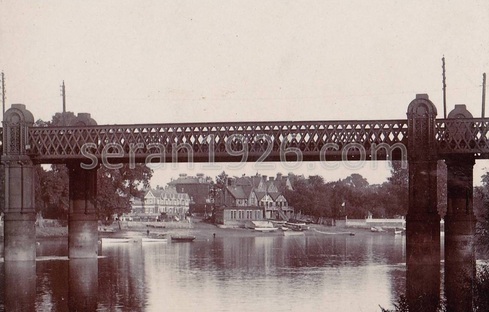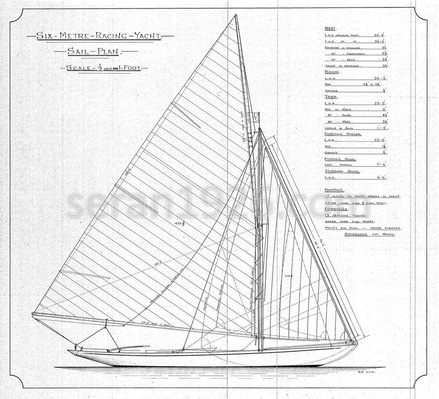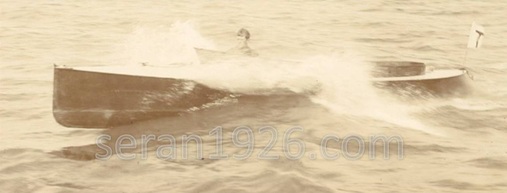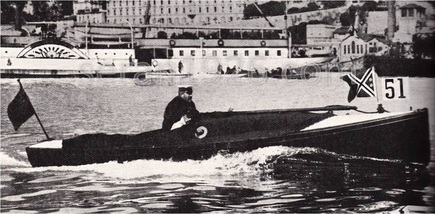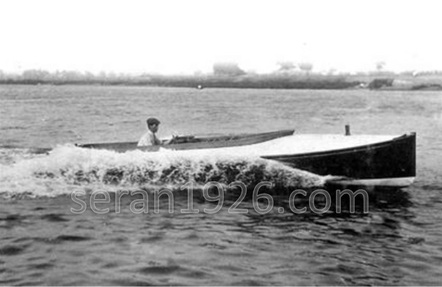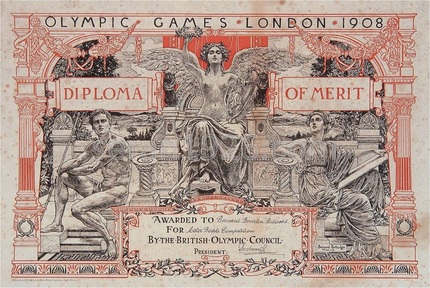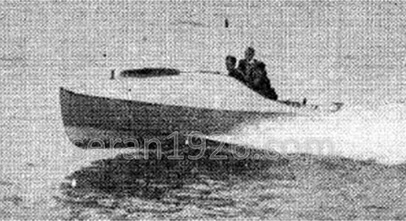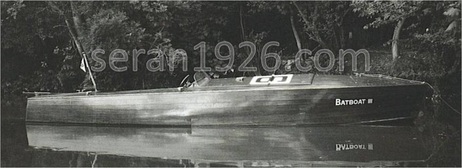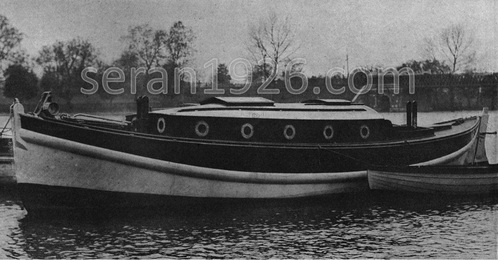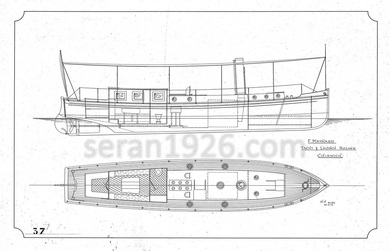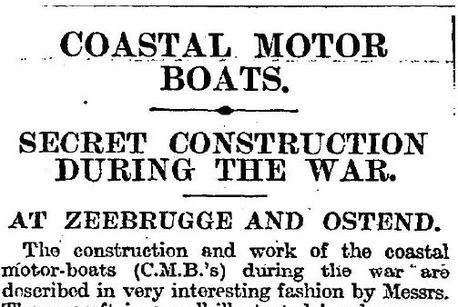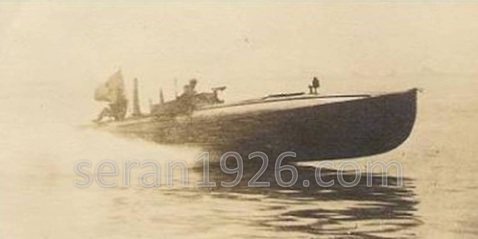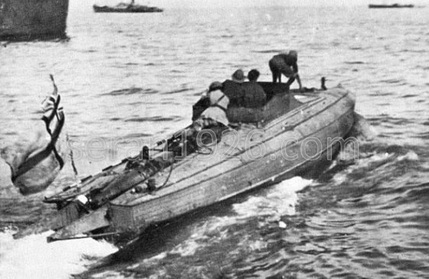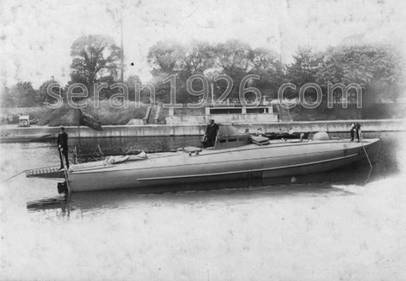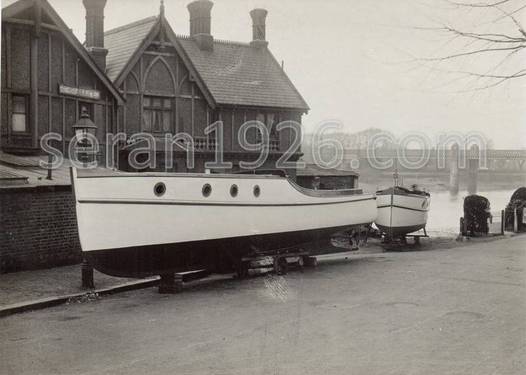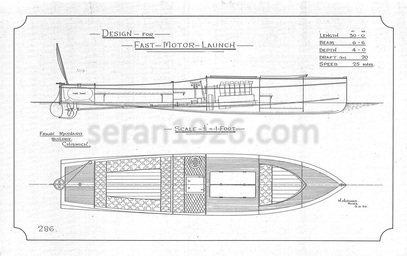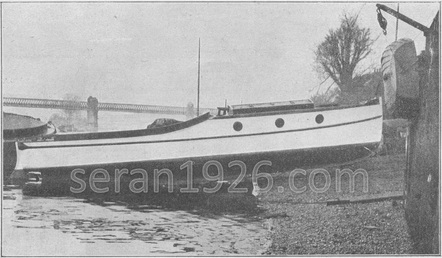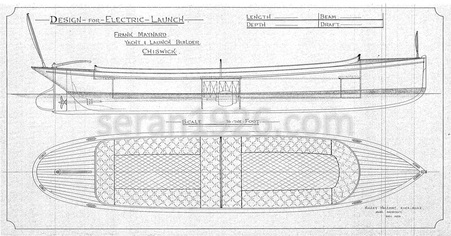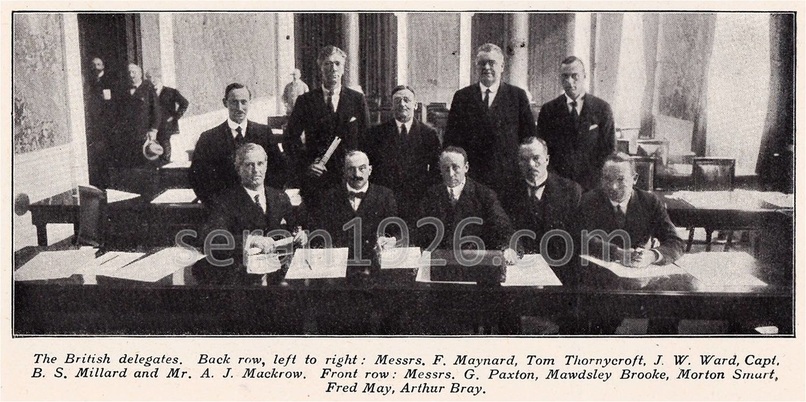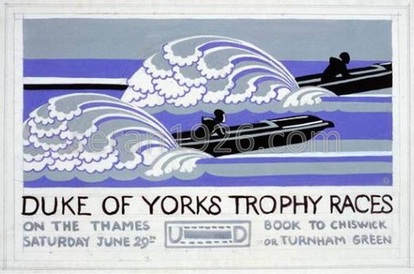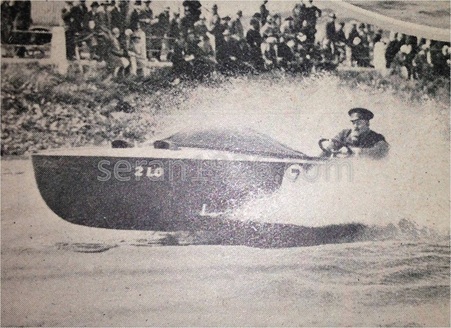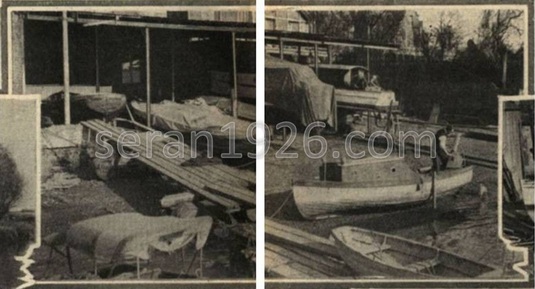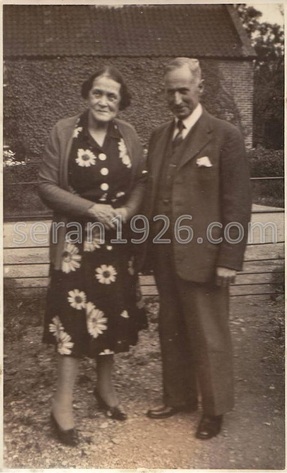Francis Thomas Maynard
By the late 1890’s Francis Thomas
Maynard was running the business his father had established in 1869 and which
he and his brothers had continued, following their father’s untimely death in
1886.
The author William Murray Graydon
provides a vivid, contemporary account of the sights and sounds of the Chiswick
waterfront:
“A little later he had threaded the quaint passage behind Chiswick Church left the sonorous hammering of Thorneycroft’s (sic) behind him, and was stepping briskly along Burlington Lane, with the high wall of the Devonshire House on his right, and on his left, far over hedges and orchards, the riverside house of Barnes. He was almost sorry when he reached Maynard’s boat-house, where he kept a couple of light and serviceable craft; but the dimpled bosom of the Thames, sparkling in the sunlight, woke a fresh enthusiasm in his heart...” (“In Friendship’s Guise”, 1899)
The International Six Metre Class Yachts
Maynard’s experience building all
types of powered and unpowered craft, his reputation for first class
workmanship and enviable client base presented him with a real opportunity to grow
the business.
Maynard’s yard continued to build
yachts in the early years of the twentieth century, although the focus
increasingly moved towards powered craft (see below). One yacht of interest,
‘Diamond’ (1905), was designed by, and built for, Warrington Baden-Powell,
eldest brother of Robert, author of ‘Sea Scouting and Seamanship
for Boys’ (1910) and founder of the Sea Scouts in 1912. He was an early
member of the Royal Canoe Club and developed the canoe as a specialised
sailing vessel.
In 1907, The International Rule
was introduced as a standardised system of classes in response to the
introduction of numerous handicap systems which had developed through the
nineteenth century and “were often local, or at best national, and often
also fairly simple, producing extreme boats which were fast but lightly
constructed and impractical”; of these, the Six Metre Class, was the most
important international yacht racing class. Maynard had considerable experience
building yachts similar in size and design and consequently, from 1908
leading yacht designers of the day approached Maynard to build their designs.
In 1908 he built the Alfred Mylne designed ‘Sibindi’
(1908) for J. W. Leuchars. In April of that year she was entered
in the first race for the newly formed class at Burnham-on-Crouch,
under the auspices of the Eastern of England Yacht Club. Later that
year, ‘Sibindi’ competed in the International Six Metre Class at the
1908 Olympic Games at Ryde, taking fourth place.
Maynard built the G. Umfreville
Laws designed ‘Gypaetos’ in 1910. Her first competitive race was the
Eastern of England’s Yacht Club race at Burnham-on-Crouch in April of that
year, competing against ‘Sibindi’ amongst others. In June 1910
‘Gypaetos’ was entered in the International Six Metre Class at the
Kiel Regatta, finishing first out of twelve entrants.
Other Umfreville Laws Six Metre designs built by Maynard
include: ‘Whim’ (1910), ‘Sioma’ (1911), ‘Bunty’ (1912) and
‘Lestris’ (1912).
In 1914, in the shadow of war,
Maynard built the Linton Hope designed ‘Edelweiss II’, ex
‘Edelweiss’, commissioned by the ‘Edelweiss Syndicate’ and registered
with the Port of Antwerp. She competed in the International Six Metre
Class at the 1920 Antwerp Olympic Games, winning Gold for
Belgium. 'Edelweiss II' continued competitive racing into the late
1920's. Another Linton Hope design, built by Maynard in 1920 (the
only Six Metre yacht built that year), ‘Tan-fe-pah’, also participated in
the 1920 Olympic Games, taking second place in the Six Metre Class based
on the 1919 International Rule. Maynard also built the Linton Hope
designed Six Metre yacht, ‘Scotia IV’ (1913).
Early Motor Boats
Maynard was fortunate that his
premises were located in such close proximity to Thornycroft’s Church Wharf
site and he was alert to the opportunities presented by the developments in
marine engineering and motor boat design which Thornycroft were pioneering
alongside a handful of others including Yarrow and Saunders.
In 1903 Maynard was subcontracted
by Thornycroft to build the 30 ft. hull of ‘Scolopendra’, Thornycroft’s entrant
in that year’s inaugural Harmsworth Trophy. Although she was underpowered
relative to Yarrow’s ‘Napier I’ the hull was considered easily the most
efficient. The ‘Scolopendra’ project was most likely the first collaboration
between Maynard and Higley Halliday, who at this time was working at
Thornycroft’s.
Maynard quickly became an
established figure in the relatively small circle of motor boat designers and
marine motor engineers. By 1905, he had established the 'Launch Motor Company' and exhibited a "well built" river launch at Olympia that year. At this time he was working closely with the naval architect James A.
Smith, Official Measurer of the Marine Motoring Association in 1905 and,
subsequently, Secretary of the Marine Motoring Association from 1907.
Maynard built a number of Smith’s designs for fast motor launches
of between 21 ft. and 26 ft. and between 2 and 3 tons between 1905 and
1910. These included ‘Takumono’ (1905), Bobolink (1905), Fleurette (1906) and
Bath-sheba (1910).
The majority of these, in
addition to others built by Maynard such as ‘Bulldog’ (1906) and the
Maynard designed, ‘Opal’ (1906), were regular entrants in the early motor
boat reliability trials organised by the Marine Motoring Association and club
meetings and races of the Motor Yacht Club and British Motor Boat Club.
Despite Thornycroft relocating
their works to Woolston from 1905, Maynard continued to work closely with
Tom Thornycroft. In 1908 Maynard built the hull of ‘Gyrinus
II’ designed by Tom Thornycroft and owned by Bernard Redwood and John
Field-Richards. She was one of three entrants in the motor boat races of
the 1908 Olympic Games winning two Gold medals. At the April 1909 Monaco
Regatta she won first place at the Monaco Motor Boat Meeting.
Rapid innovation in motor boat
design and marine engineering had, by 1908, resulted in the development of
the first racing hydroplanes, characterised by a stepped, planing hull. In
another interesting parallel, Higley Halliday had spent several years between
1907 and 1909 developing this technology in Merseyside.
In 1910 Thornycroft approached
Maynard to build the hull for one of the earliest racing hydroplanes, ‘Miranda
IV’ (based on the Lloyd's Registers; the author acknowledges the widespread accreditation
to Hart Harden) and several years later, another of their hydroplane designs,
‘Onward II’ (1913). Maynard, together with J. Samuel White & Co.,
Cowes, also built ‘Batboat III’ (1914) designed by and built for John
Montague Batting as a contender for the 1914 British International Trophy,
which was cancelled on the eve of the First World War.
Higley Halliday M.I.N.A.
In 1911 Maynard entered into
partnership with the Chiswick based naval architect and marine motor engineer,
Higley Halliday. Maynard had known Halliday since the early 1900’s when Halliday
was employed at Thornycroft’s premises at Church Wharf. Both were involved in
designing and developing early motor boats (from circa 1902) and competed
against each other in the Reliability Trials of 1906 (Maynard with ‘Opal’,
Halliday with ‘Albatross’ and ‘Iris II’) in Southampton Water. Both men had
worked closely with Tom Thornycroft and were involved in the development and
construction of early racing hydroplanes (from circa 1908) Maynard and Halliday
knew each other socially too; both were Freemason’s initiated into the Royal
Alfred Lodge, No. 780 (in 1906 and 1904 respectively).
Halliday had returned to London
in 1909 and worked increasingly closely with Maynard, living a short walk from
the boat-house at 22 Strand-on-the-Green in 1911. From 1911 Maynard built a
number of Halliday’s designs including the 36 ft. motor yacht ‘Amice’ (1912)
and the motor launch ‘Falcon’ (1912) amongst others. Interestingly,
Maynard was the registered owner of the motor launch 'Falcon' in the early
1920's. Maynard continued to build yachts for other designers during this
period including the Linton Hope designed, auxiliary yachts ‘Black Arrow’, ex ‘Noah’
(1912) lost at Dunkirk in 1940 and ‘Mollihawk IV’ (1914).
First World War
In
early 1915, Thornycroft had shown the Admiralty designs for a type of
small boat that would skim the water at high speed, while possessing
sea going qualities and carrying a torpedo. These were based on the
designs of pre-war hydroplanes. Independently, three naval officers,
Lieutenant’s Hampden, Bremner and Anson of the Harwich Force, had
persuaded the Admiralty that such craft should be developed.
Thornycroft
were instructed by the Admiralty to start trials and the development of
what was to become the Coastal Motor Boat (C.M.B.), which continued through the
second half of 1915 (it seems likely that Higley Halliday was also approached
to assist in the development of the Coastal Motor Boat). Detailed designs were
prepared and submitted to the Admiralty in January 1916, which were approved.
An initial order for twelve vessels was placed by the Admiralty, with the first
three boats being completed in April 1916. Subsequently this order was
increased and a twin screw, 55 ft. variant, armed with twin torpedoes was ready
for service in April 1917. In total, the Admiralty was to order over
one-hundred C.M.B.’s which was more than the Thornycroft yard at Platt’s
Eyot could deal with.
“Other British boat builders had to be drafted in to help and soon the list of yard’s working on C.M.B.’s read like a Who’s Who of the classic age of British boatbuilding: Hampton Launch Works, Salter Brothers, Tom Bunn & Co., Frank Maynard, J.W. Brook & Co., Wills and Packham, Camper and Nicholsons and many others. Most are long gone now, but in 1917 they were the finest yards in Britain.” ('Operation Kronstadt', Harry Ferguson)
In 1918, Maynard built three 40
ft. designs: C.M.B.’s ‘46’, ‘53’ and ‘54’, fitted with FIAT
petrol engines. Their service record is not known but all three survived
the war. C.M.B. ‘53’ was discarded in 1920 and C.M.B.’s ‘46’ and ‘54’
were discarded in 1921, either being sunk as targets or sold into private
ownership.
The same year, Maynard also
constructed six of the larger, 55 ft. variants: C.M.B.’s ‘32A’, ‘38B’,
‘66BD’, ‘71A’, ‘85C’ and ‘88BD’ which were fitted with either Thornycroft
V12 250 b. h. p., Green 12 or Sunbeam petrol engines. C.M.B. ‘71A’ was
lost on 15 October 1918, having departed Dunkirk on the night of 14
October for a patrol off the Belgian coast. At 21.45 hrs she was involved in a
collision with C.M.B. ‘37’, which returned to Dunkirk. C.M.B.
‘71A’ continued the patrol but failed to return next morning. A search failed
to find her and she was assumed to have foundered with all those aboard.
The other Maynard built C.M.B.’s survived the war and were gradually
discarded: ‘66BD’ and ‘88BD’ (1921), ‘32A’ (1924), ‘38B’ (1928) and ‘85C’
(1932).
Coastal Motor Boats saw limited
service during operations at Dunkirk, Zeebrugge and Ostend, their
capability not being fully demonstrated until August 1919 when Gus Agar
R.N. used them to devastating effect against the Bolshevik fleet at
Kronstadt.
Post War Years
From 1919 Maynard’s yard resumed normal business (in so far as possible given the structural changes in the industry which had occurred during the war years), building several vessels to the designs of J. A. Smith (such as the 25 ft. motor launches 'Caress', 1919 and ‘Saunterer’, 1922) and J. I. Thornycroft (‘Eileen’, 1919, for T. Desnos of the B.M.B.C.).
Clearly then the arrangement
with Halliday was not exclusive to either party (for instance Halliday’s 1921
design for the motor yacht ‘Seawolf’, was built by Bowers & Phelps, Putney)
but many of the vessels built by his yard between 1920 and 1926 were designed
by Higley Halliday.
Maynard constructed the
majority of Halliday’s motor yacht designs, including ‘Splash III’
(1920), ‘Hope’ (1921), ‘Rosemary’ (1921), ‘Beowulf’ (1922), ‘Venture’
(1926) and ‘Seran’ (1926) and also a good number of motor launches. In
1921 Maynard developed his own standardised design for a 35 ft. cabin cruiser
“for general cruising and utility work”, which bears more than a passing
resemblance to Halliday’s motor yachts. In November 1921 Maynard exhibited at
the White City Motor Exhibition.
In addition to recreational motor
launches and yachts, Maynard also built a range of commercial craft,
although the output is hard to quantify given the absence of yard lists.
It’s clear that Maynard built a number of Halliday’s designs for
commercial vessels, including an electric launch (1924) and a
hydraulic propelled motor tug (1925). The yard also built a number of
passenger launches during this period, including Halliday’s designs for 50
ft. (1923) and 40 ft. (1925) versions. We know from a brief article in The
Times in 1923 that Maynard built the motor launch for The Transport and
General Workers’ Union and in addition it’s likely that he continued to
build a broad range of utility launches for commercial use and small fishing
vessels throughout the 1920’s.
By the mid 1920’s Maynard was an established and respected figure in the industry. For instance, in October 1922 Maynard was a delegate to the Brussels Conference, which resulted in the formation of the New International Motor Yachting Union. In September 1923 Maynard attended ‘The Future of the Motor Boat’ discussion at the Olympia Exhibition together with senior members of the Marine Motoring Association, British Motor Boat Club and Royal Motor Yacht Club hosted by the Society of Motor Manufacturers and Traders. By 1926, Maynard was vice-president of the Ship and Boat builders’ Association, Ltd. an organisation which could count amongst its membership some of the most respected names in the industry: Mr. W. B. Bates (James Taylor and Bates Ltd.), Mr. J. H. Salter, R. Messum (E. Messum and Sons, Ltd.), A. Mylne (Bute Ship Dock Co. Ltd.), T. Bunn (Tom Bunn and Co. Ltd. and R. J. Turk (J. S. Turk and Sons) amongst others.
Duke of York's International Trophy
Attempts to re-invigorate
interest in international motor boat racing and development in the post
war period were hindered by the substantial cost of entering boats for the
Harmsworth British International Trophy. A reaction to this was the
development of small, planing powerboats, fitted with 1.5 litre engines.
The first, ‘Mr. Poo’, built by Mr. Jack Brooke in 1922, was a 15
ft. hydroplane fitted with a 1.5 litre, 30 h. p. engine, affording a
maximum speed of 28.25 knots. In 1923, the International Motor Yachting
Union recognised the 1.5 litre ‘‘Mosquito Class’ powerboat and, the
following year, 1924, Count Johnston-Noad won the inaugural Duke of
York’s International Trophy with ‘Miss Betty’. In 1925, the
eliminating trials for the British fleet and Trophy races were held
on the Thames at Chiswick, the course starting outside Maynard’s boat-house:
“From Putney to Kew on Saturday the Thames was a centre of rare interest to numbers of people gathered at various points on its banks, fascinated by the speed of the motor-boats which, with considerably more than half their keels out of the water, caused a backwash that churned the river into foam and dashed the water on to the banks in miniature seas... The course extended from Maynard’s boat-house at Kew to Putney and equalled 7 – 9 sea miles. Many people gathered at the start, both on the lawn of Cromwell House, on the river bank, and on craft moored in the river.”
In part owing to the success
and popularity of the races, one of the joint organisers, the British
Motor Boat Club took a lease on Cubitt’s Dock, Hartington Road,
Chiswick, just down river from Maynard’s yard in November 1925. It
was reported in the press at the time that the club had “come to live
at Chiswick” and “would now have club rooms at the dock at Chiswick, so
that it would be working here in full force.”
In 1926, The Duke of York’s
International Trophy was again held on the Thames at Chiswick. In January,
Maynard was appointed a delegate to the Marine Motoring Association -“the
governing body of all motor boat sport” - ahead of the Trophy Races. In advance
of the races, the secretary of the Marine Motoring Association Mr.
John Avila A.M.I.E.E. was invited to the fortnightly Chiswick Rotary Club
luncheon, speaking “a good deal about the contest and of motor boat racing
in general.” Outlining the development of the 1.5 litre hydroplanes that
would be contending the Trophy, Mr. Avila explained their design and
construction and commented that:
“At Chiswick, Rotarian Maynard has built some very fine and fast boats.”
Thanking
Mr. Avila, ‘Rotarian’ Maynard said:
"He could promise them that the boats would be better than ever this year. Last year only one of them had a super-charge: this year all would have them. He believed America was sending over some very hot stuff.”
The eliminating trials for the
British Fleet commenced on 11 June with eight entrants competing over a
thirty-two mile course of six laps. One of the new entrants that year,
‘2LO’ (subsequently renamed 'Hornet') was built by Maynard for Mr. Fred May
and "had run throughout with absolute reliability and
consistency", finishing second despite a fouled propeller.
The Late 1920's and 1930's
The partnership with Higley
Halliday had dissolved by 1926 and throughout the late 1920’s and 1930’s
the volume of boats built at Maynard’s yard steadily declined, during
which period Maynard started pro-actively advertising his services in trade
magazines including The Motor Boat. In January 1927, The Motor
Boat reported that:
“A visit to the boat building yard of Mr. Frank Maynard, at Chiswick, left us with the impression that he was by no means contented with the number of orders received during the past few months, the only boats under construction for owners at the time of our call being two 25 ft. cruisers...Mr. Maynard is also building a fast 26 ft. river launch for stock, as he is convinced that there should be a certain demand for this type of boat... About a dozen boats of various types were laid up, and two small fishing craft were being installed with auxiliary engines”
Only a small number of new
vessels were recorded in the Lloyd’s Registers over this period including
the Maynard designed, 38 ft. motor yacht ‘Wanderer’ (1926), a 26.4 ft.
auxiliary yacht, ‘Avon’ (1930) and the 35 ft. motor yacht, ‘Noah’ (1931)
designed by E. L. Comfort. Maynard continued to build commercial vessels,
including the 55 ft. passenger launch 'Britannic II' (1930) also designed
by E. L. Comfort. In addition, he also undertook alterations to existing
vessels including the motor yacht ‘Manana’, originally built by Thornycroft in
1917 (1930) and ‘Seran’ (1934) and conversions, such as the 28 ft.
converted lifeboat 'Lady Irene' (1928).
|
Maynard retired in 1938 at the
age of sixty-two. His son Francis (b. 1903) was working as a ‘planter’ by
the late 1930’s which took him and his young family to Singapore and Malaysia.
Maynard’s daughter, Violet (b. 1898) married and moved to Chippenham,
Wiltshire, where her father spent his later years. Frank Maynard died in
1952.
|
